January 05, 2021
. 15 min readGatsby Tutorial: Sourcing Data and Content
In our Gatsby site project at the moment, the content being displayed in the browser is static.
That is, we are writing the content directly in the component JSX.
But as the site grows, this approach is not going to scale. Instead, you’ll want to store data outside components and dynamically load them into your site.
In this section, you’ll learn how to get data into your Gatsby site using the GraphQL API. Well, if you have never used GraphQL, it’s fine. We will go over the basics as we use them.
GraphQL is just a query language that is used to load data to a client. It lets the client specify exactly what data it needs.
You will see how this works in a moment.
Gatsby, unlike other site generators, allows us to source data not only from the file system like Markdown but also from APIs, databases, CMSs like Contentful, WordPress, Drupal etc.
This is what makes Gatsby very interesting and powerful.
Let’s start with the basics.
In your Gatsby site, you would want to reuse and easily change some data like the site title, description, author of the site, social handles e.t.c. These data can be stored in one location (where you can easily change them) and reference them from other files.
This location is the siteMetadata object in the gatsby-config.js file. We do not have this object in the config file yet.
So go inside the gatsby-config.js file and add another property named siteMetadata to the module.export object like this:
module.exports = {
siteMetadata: {
title: 'Ibas Majid',
description: 'I teach JavaScript, React, GraphQL and Gatsby',
author: 'Ibaslogic',
},
plugins: ['gatsby-plugin-sass'],
};
You can modify the string in the object to reflect your site data.
Save the file.
Now, you need to query these data and use them in your site. To do this, you will need to know how to use a tool called GraphiQL. This tool is an in-browser IDE (integrated development environment) for exploring GraphQL API.
You can access this tool at localhost:8000/___graphql.
Note: There are 3 underscores in the URL and it is only available when your site’s development server is running.
Once you open the tool, click on the Explorer button at the top to see the Explorer panel.

This panel makes it super easy to construct your queries by clicking through available fields instead of manually typing out these queries.
If you prefer typing these query out by hand, there are shortcut keys available to make the tool easy to use. For instance, you can use Ctrl + Space or Shift + Space to bring up autocomplete window.
In a moment, we will explore the tool together. So keep reading.
Sourcing Content From the siteMetadata
We will start by sourcing the data that we specified in the siteMetadata earlier. These data are available inside the site dropdown field in the Explorer panel. But they won’t show up yet.
This is because anytime you change the gatsby-config.js file, you’ll have to restart the development server and refresh GraphiQL. So restart gatsby develop and check the site dropdown field again.
As seen in the image below, the siteMetadata field has the data we provided (in the gatsby-config.js file) available as selections. Select the fields you want and click on the play button to run the query.
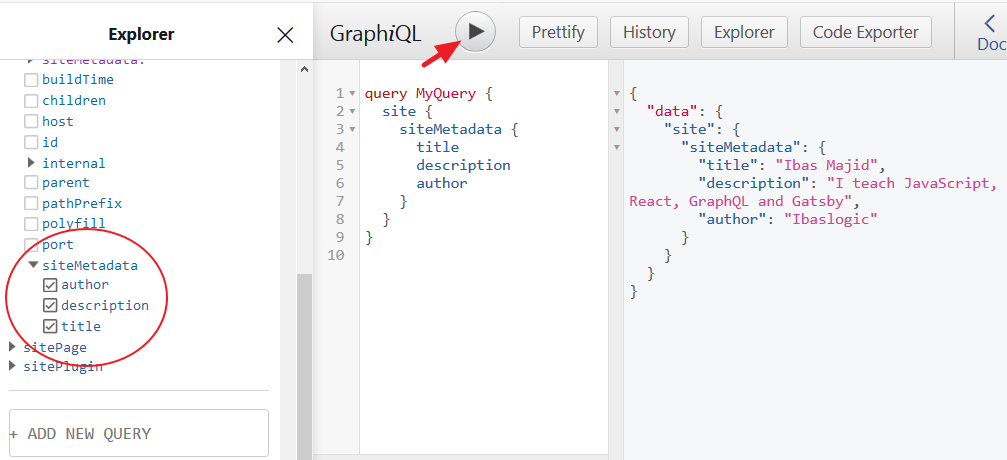
The query result is displayed in JSON format on the right side.
In GraphQL, you can perform three main types of operations – The query, mutation and subscription. But with Gatsby, we are only concern about the query operational type.
The query and the MyQuery (which is the operational name) as seen in the GraphiQL are optional. You can decide to omit them from your queries once you are sure that no other query will be on the page.
Now that we are getting the data we want, we will move the query into our Gatsby site and load these data.
Query Types
Gatsby allows us to load data into a component through the page query or the StaticQuery. Now, the type of query to use depends on the component type. Whether it is a Page or Non-page component.
A page component lives in the src/pages directory and becomes site pages automatically. This type can use either of the query types.
On the other hand, the Non-page component is embedded in other component or multiple page components. For instance, the Header, Footer, Layout components. This type of component can only use the StaticQuery type or its React hooks version, useStaticQuery.
In our site, we want to get the site title and description in the Header component and the author in the Footer component. To do this, we will make use of the StaticQuery or useStaticQuery. I prefer the latter.
So let’s go ahead and make some changes to our header.js file and use the useStaticQuery hook. Update this import statement:
import { Link } from 'gatsby';
To:
import { Link, useStaticQuery, graphql } from 'gatsby';
Then, add this just above the return statement:
const data = useStaticQuery(
graphql`
query {
site {
siteMetadata {
title
description
}
}
}
`
);
Finally, reference the site title and description in the return statement using {data.site.siteMetadata.title} and {data.site.siteMetadata.description} respectively. Your file should look like this:
import React from 'react';
import { Link, useStaticQuery, graphql } from 'gatsby';
import headerStyles from './header.module.scss';
const Header = () => {
const data = useStaticQuery(
graphql`
query {
site {
siteMetadata {
title
description
}
}
}
`
);
return (
<header className={headerStyles.header}>
<div className={headerStyles.overlay}></div>
<div className={headerStyles.heroContent}>
<p className={headerStyles.brand}>
<Link to="/">{data.site.siteMetadata.title}</Link>
</p>
<p className={headerStyles.description}>
{data.site.siteMetadata.description}
</p>
</div>
<nav className={headerStyles.navContainer}>...</nav>
</header>
);
};
export default Header;
Save the file.
Now, if you update the site title and description in the gatsby-config.js file, your changes should show up immediately in the frontend.
In the code, we imported the useStaticQuery hook which takes a GraphQL query and returns your data. The data is then injected in the JSX.
You’ll notice we are querying only the data that we need – i.e title and description. This is one of the reasons GraphQL is so powerful.
Moving on.
Challenge!
Update the Footer component to dynamically load the author name.
Done?
Let’s do it together!
In the footer.js file, import useStaticQuery and graphql from the gatsby module like so:
import { useStaticQuery, graphql } from 'gatsby';
After that, add the following just above the return statement:
const data = useStaticQuery(
graphql`
query {
site {
siteMetadata {
author
}
}
}
`
);
Then, reference the author name in the jsx using {data.site.siteMetadata.author} so it looks like this:
<footer className={footerStyles.siteFooter}>
<div className={footerStyles.container}>
<p>
Site developed by {data.site.siteMetadata.author} ©{' '}
{new Date().getFullYear().toString()}{' '}
</p>
</div>
</footer>
Save the file.
Test your work by modifying the author name in the gatsby-config.js file and see the changes reflect in the frontend.
Sourcing Content From the File System
Now that you know how to source content from the siteMetadata, let’s move a step further by sourcing content that will be displayed on the blog page.
I mentioned earlier that we can source blog post content from the local files, CMSs or from any other sources. But in this tutorial, we will source our blog posts content from the local files.
To achieve this, we will make use of two plugins.
First, a source plugin called gatsby-source-filesystem that will fetch the raw content and allow us to query data about the files. The second plugin, gatsby-transformer-remark, will allow us to query the data inside the files and will transform the content (i.e markdown content) into the format we want (i.e HTML).
Let’s see how to achieve this.
We will start by creating Markdown files for our blog post. So go inside the src directory and create a folder called posts. Inside this folder, create two Markdown files named first-gatsby-blog-post.md and second-gatsby-blog-post.md.
In the first-gatsby-blog-post.md file, add the following content:
---
title: "First Gatsby Blog Post"
date: "2020-01-18"
---
Lorem ipsum dolor sit amet consectetur adipisicing elit.
## Excepturi maxime
reprehenderit accusamus, explicabo eligendi necessitatibus soluta! Ipsam mollitia alias temporibus dicta
1. omnis earum nobis
2. architecto, quia
3. officiis aperiam
4. voluptate quaerat
Also, add this content to the second-gatsby-blog-post.md file:
---
title: "Second Gatsby Blog Post"
date: "2020-01-19"
---
Seprehenderit accusamus, explicabo eligendi necessitatibus soluta!
## Ipsam mollitia
alias temporibus dictorem ipsum dolor sit amet consectetur adipisicing elit.
## Excepturi maxime
omnis earum nobis architecto, quia officiis aperiam voluptate quaerat.
Save your files.
As seen in the frontmatter (the block surrounded in dashes), we specified the post's title and date. You can inject any piece of data (like the tags, categories, featured image URL, posts description etc) here.
Now, we need to tell Gatsby to source content from the local files using the gatsby-source-filesystem. In your terminal, stop the development server and install the plugin at the root of the project by running:
C:\Users\Your Name\ ibaslogic-gatsby-tutorial > npm install gatsby-source-filesystem
Then add it to your gatsby-config.js so it looks like this:
module.exports = {
siteMetadata: { ... },
plugins: [
"gatsby-plugin-sass",
{
resolve: "gatsby-source-filesystem",
options: {
name: "src",
path: `${__dirname}/src/`,
},
},
],
}
With this configuration, we are telling Gatsby to source content from the file system. This includes everything in the src directory including the images folder.
Note: To embed expression within a string, we use template literals (
` `).The
__dirnameis a method of NodeJS that returns the absolute path of the currently running file. There are 2 underscores before the dirname.
Save your file and restart the development server. Now let’s head over to GraphiQL IDE and see what has been added. You can find all the details about the src files inside the allFile -> edges -> node dropdown in the Explorer panel.
Remember, the source plugin allows us to query data about the files. The image below shows how we can query our file names, directory and the extensions.

As seen in the query area, you can bring up autocomplete window using the Ctrl + Space and add more fields to the query.
Now that we are fetching the local files, let’s go ahead and install the gatsby-transformer-remark plugin that will transform the available Markdown files (.md) into HTML. Back to your terminal, stop the development server and run this installation:
npm install gatsby-transformer-remark
Then add it to the gatsby-config.js file. The plugins array should now look like this:
plugins: [
"gatsby-plugin-sass",
"gatsby-transformer-remark",
{
resolve: "gatsby-source-filesystem",
options: {
name: "src",
path: `${__dirname}/src/`,
},
},
],
Save the file. Start the development server and refresh the GraphiQL IDE.
You’ll notice the addition of allMarkdownRemark and markdownRemark in the Explorer panel. We will make use of allMarkdownRemark to fetch a list of post for our blog page and later use the markdownRemark to fetch the individual post.
If you explore some of the fields that are available on the node of the allMarkdownRemark, you will have something like this:
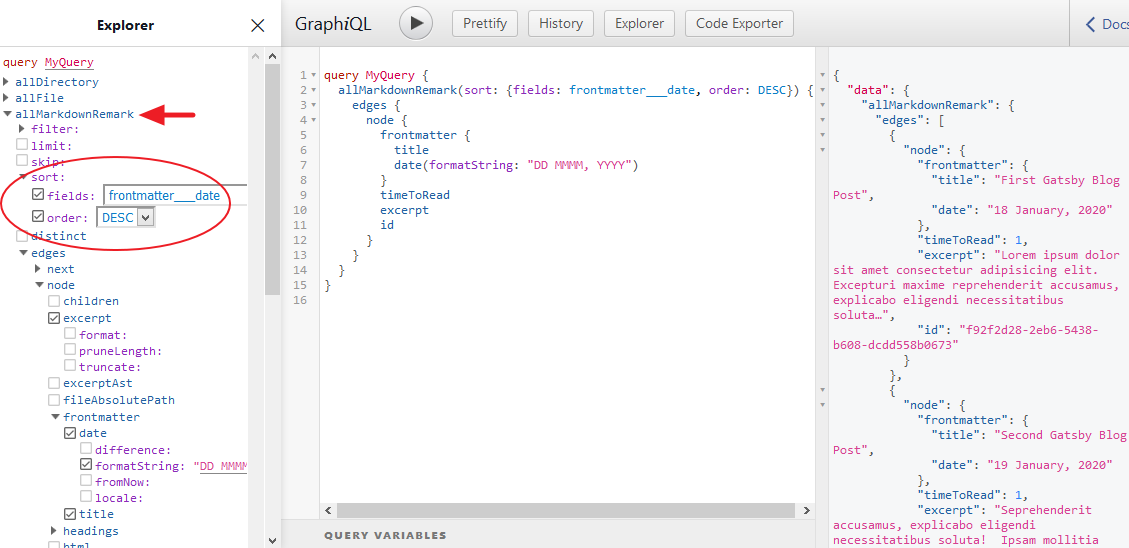
In the query area, you’ll notice we are passing the sort argument to the allMarkdownRemark to structure the blog posts in descending order of the frontmatter’s date field. Remember we specified the date alongside the title in the frontmatter of our Markdown files.
As seen in the Explorer panel, you can also pass a number of arguments (filter, limit and skip) to your query. For instance, you can reduce the total number of results from a query by specifying the limit. Also, you can omit a number of results through the skip.
Now that we have the data we need, let’s render them in the blog page of our site. So go inside the src/pages/blog.js file and update it so it looks like this:
import React from 'react';
import { useStaticQuery, graphql } from 'gatsby';
import Layout from '../components/layout';
const Blog = () => {
const data = useStaticQuery(
graphql`
query {
allMarkdownRemark(
sort: { fields: frontmatter___date, order: DESC }
) {
edges {
node {
frontmatter {
title
date(formatString: "DD MMMM, YYYY")
}
timeToRead
excerpt
id
}
}
}
}
`
);
return (
<Layout>
<ul>
{data.allMarkdownRemark.edges.map((edge) => {
return (
<li key={edge.node.id}>
<h2>{edge.node.frontmatter.title}</h2>
<div>
<span>
Posted on {edge.node.frontmatter.date}{' '}
<span> / </span> {edge.node.timeToRead} min read
</span>
</div>
<p>{edge.node.excerpt}</p>
</li>
);
})}
</ul>
</Layout>
);
};
export default Blog;
Save the file and check the frontend. You should have your posts displayed on the blog page.
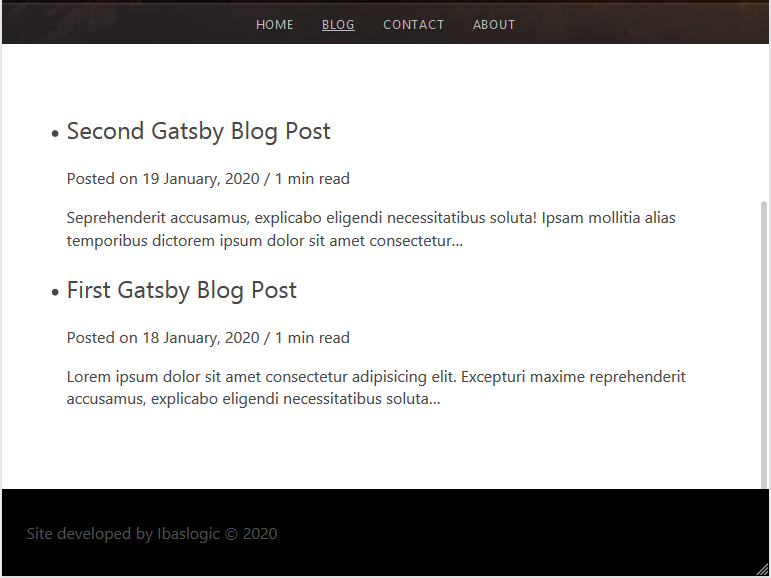
So what did we do?
If you take a look at the returned data in the GraphiQL, you’ll see that Gatsby structure its content as a collection of objects inside the edges array. We are getting each of these objects (representing individual post data) by looping through the edges array using the map() method.
From there, we are getting the data we need in our JSX markup. You should be familiar with all of these if you have a basic understanding of React.
Now that we have a list of posts on the blog page, let’s go ahead and create a single post page.
Creating the Single Post Page
At the moment, we are only rendering the excerpt of our markdown content on the blog page. Later, we will get to display the featured image as we have it in the finished project. But before that, let’s see how to generate the single post page.
Imagine you are creating a React component in the src/pages directory for each of the single blog posts. Remember, every component in this directory automatically becomes a page. This is not something you’d want to venture in.
Instead, you will learn how to dynamically generate the single post page using Gatsby node API. We can achieve this in three simple steps:
- Generating the page slug
- Creating the blog post page template
- Generating a new page for each post.
Note: The first step is only applicable if you are sourcing your content from the markdown files. For CMSs like Contentful, you wouldn’t need to create slugs yourself.
Generate Slugs for Pages
Here, we will make use of a Gatsby node API called onCreateNode. This API is called when a new node is created and will allow us to attach new data to the individual node. In our case, we will attach the generated post slug.
Let’s see how to generate the slug and implement this API. We will start by creating a file (if not exist yet) called gatsby-node.js in the root directory.
In the file, add the following:
exports.onCreateNode = ({ node }) => {
if (node.internal.type === 'MarkdownRemark') {
console.log(JSON.stringify(node, null, 4));
}
};
Once you save the file and restart the development server, you’ll see that the MarkdownRemark node types get logged to the terminal.
In most cases, you would want to use each markdown file name to generate the page slug.
You can get that done by targeting the fileAbsolutePath as seen in the image below and then extract the file names and use as the page slug.
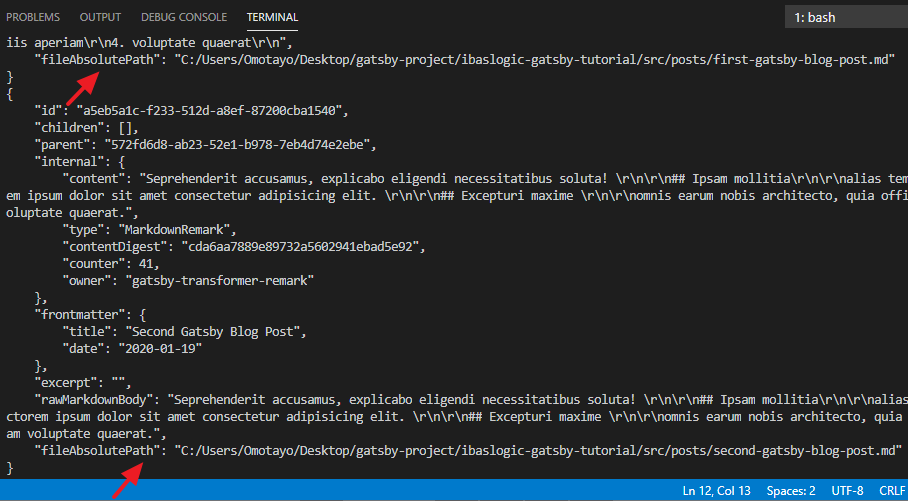
To do that, update your gatsby-node.js file so you have:
const path = require('path');
exports.onCreateNode = ({ node }) => {
if (node.internal.type === 'MarkdownRemark') {
const slug = path.basename(node.fileAbsolutePath, '.md');
console.log(slug);
}
};
Here, we are using the NodeJS path.basename() method to extract the filename from fileAbsolutePath. After restarting the development server once again, you should have the slugs for each of the markdown file.
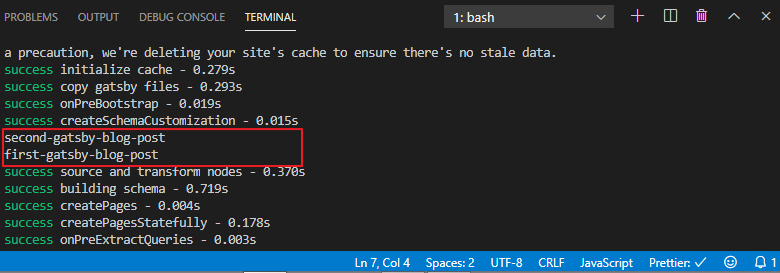
Now that we are generating the slugs, we will add them onto the MarkdownRemark nodes so that they will be available for query with GraphQL.
Update the gatsby-node.js file so you have:
const path = require('path');
exports.onCreateNode = ({ node, actions }) => {
const { createNodeField } = actions;
if (node.internal.type === 'MarkdownRemark') {
const slug = path.basename(node.fileAbsolutePath, '.md');
createNodeField({
node,
name: 'slug',
value: slug,
});
}
};
The createNodeField which is a function comes from the actions object of the onCreateNode. It enables us to create additional fields on nodes.
Once you save the file and restart the development server, you can now access the field value (i.e slug) at node.fields.slug. In the GraphiQL, you should produce something like this.
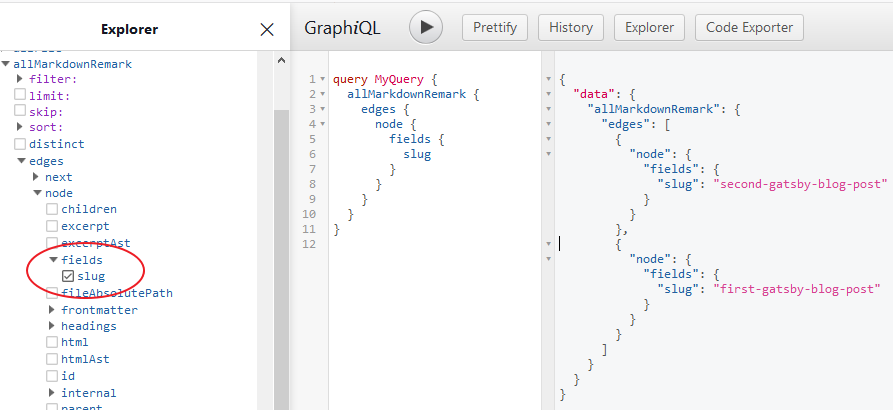
Now that the slugs are being generated, let’s move on to step two which is creating the blog post template. In this template, all you need to do is to create a React component.
This single component will be used to render all of the single blog posts. In the src directory, create a new folder called templates. In this folder, create a file named blog-post.js and add the following:
import React from 'react';
import Layout from '../components/layout';
const BlogPost = () => {
return (
<Layout>
<div>This is the single post template</div>
</Layout>
);
};
export default BlogPost;
In the meantime, we are rendering a simple text in the template file. We will update the file in a moment. For now, let’s generate a new page for each post. To do this, we will make use of another Gatsby node API called createPages that allows us to dynamically add pages.
Add the following code at the bottom of the gatsby-node.js file:
exports.createPages = async ({ graphql, actions }) => {
const { createPage } = actions;
const response = await graphql(`
query {
allMarkdownRemark {
edges {
node {
fields {
slug
}
}
}
}
}
`);
response.data.allMarkdownRemark.edges.forEach((edge) => {
createPage({
path: `/blog/${edge.node.fields.slug}`,
component: path.resolve('./src/templates/blog-post.js'),
context: {
slug: edge.node.fields.slug,
},
});
});
};
In the code, we are making use of the createPages API function to dynamically create a single post page based on the markdown slug.
Here, we are using the async/await syntax to get a promise response from the graphql function. This response holds all of the data we need.
So we looped through its edges array (which contains the list of posts) and then dynamically create each post page by calling the createPage function.
This function accepts an object where we defined the path for visiting the single blog post, the component parameter where we specified the absolute path to the template file while the context contains the data (i.e slug) we are passing to the template file.
Now let’s restart the development server.
At this point, your blog post pages are created. You can visit this URL, localhost:8000/blog/first-gatsby-blog-post from your browser address bar and see your new page.
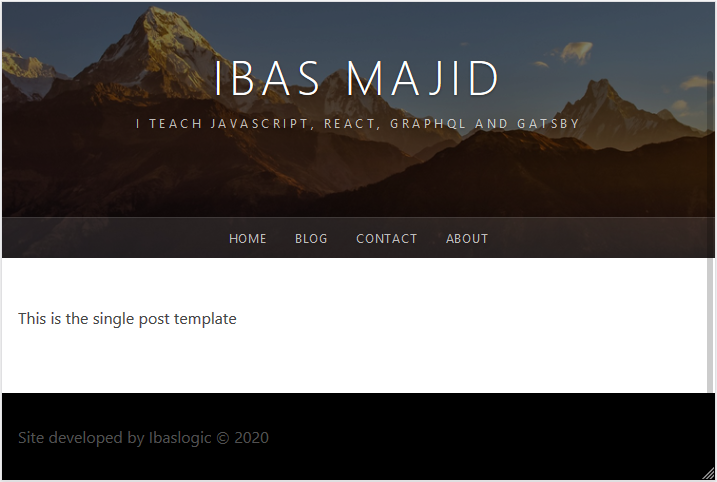
The content of this page is coming from the template file, blog-post.js. Remember, we only have a simple text in its JSX. This is definitely not what we want. Instead, we will display data from the markdown file.
Rendering Post Data in the Blog Template
To render our data, we will set up a GraphQL query that will dynamically accept the post slug and return the blog post.
In the meantime, let’s play with the GraphiQL IDE and see how it is done. So refresh or re-open the tool. Here we will make use of markdownRemark query to get the single post.
In this query, we will target each of the posts by their respective slug through the fields argument.
To do this, we will make use of the query variables (a set of data you can pass into your query). In our case, we will be passing-in the dynamic slug.
Your query should look like this.
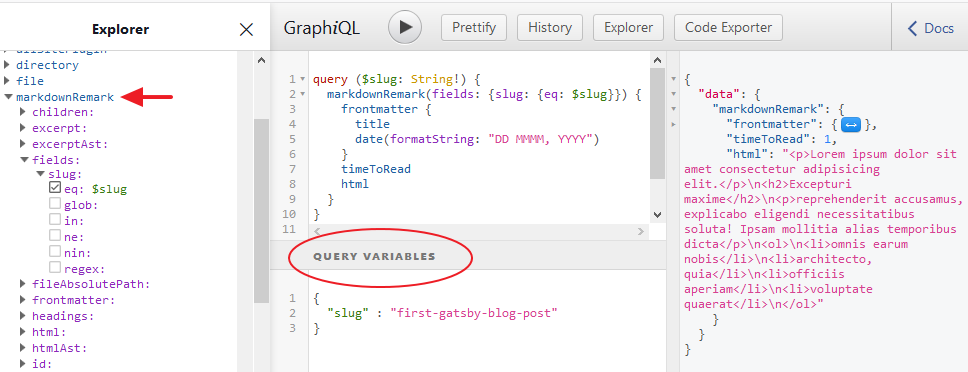
As seen above, GraphiQL provides us with a way to pass variables in the query. But in the template file, the variable will come from the context object of your gatsby-node.js.
Remember we specified the slug in the object.
Note: Variables are prefixed with
$, so theslugproperty becomes$slugargument in the query.
Now let’s take this query and use it to exhibit each of the single posts. So update the src/templates/blog-post.js file so you have:
import React from 'react';
import { graphql } from 'gatsby';
import Layout from '../components/layout';
export const query = graphql`
query ($slug: String!) {
markdownRemark(fields: { slug: { eq: $slug } }) {
frontmatter {
title
date(formatString: "DD MMMM, YYYY")
}
timeToRead
html
}
}
`;
const BlogPost = (props) => {
return (
<Layout>
<div>
<h1>{props.data.markdownRemark.frontmatter.title}</h1>
<span>
Posted on {props.data.markdownRemark.frontmatter.date}{' '}
<span> / </span> {props.data.markdownRemark.timeToRead} min
read
</span>
<div
dangerouslySetInnerHTML={{
__html: props.data.markdownRemark.html,
}}
></div>
</div>
</Layout>
);
};
export default BlogPost;
Save the file and revisit http://localhost:8000/blog/first-gatsby-blog-post.
You should have your post rendered.
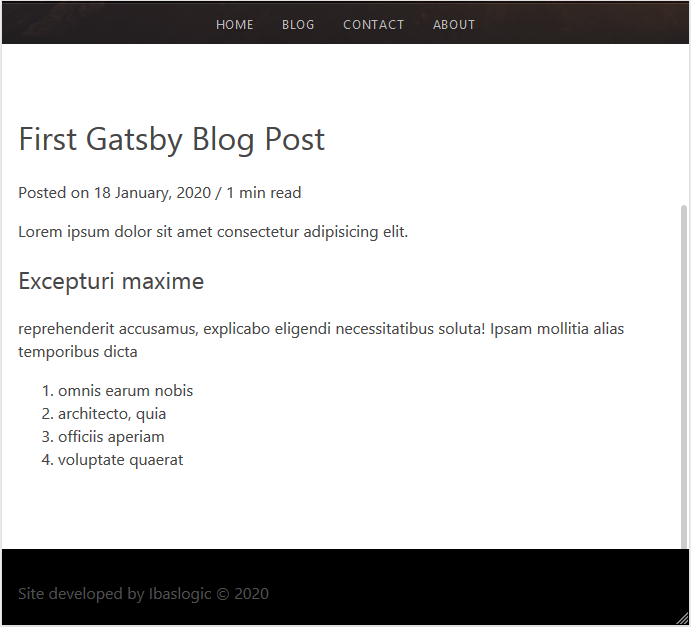
Nice one!
In the code, you will notice we are not using the useStaticQuery hook for our query as we have been doing. This is because the static query cannot take query variables. Instead, we are using the page query.
This type of query lives outside of the component definition as you can see in the template file.
Now the result of the query is injected into the React component through the props. From there, we are accessing the data and using them in our JSX markup.
Note: In the JSX, we are using the
dangerouslySetInnerHTMLprop to render HTML for our blog posts.
Now, we have the template in place for each and every blog post. Let’s go ahead and link to these new pages from the blog page.
To achieve this, all we need is dynamic slugs.
Earlier, I mentioned that the slugs are accessible at node.fields.slug. So you can modify the blog page query to have access to the slugs and use them to generate the link.
Update your src/pages/blog.js file so you have:
import React from 'react';
import { useStaticQuery, graphql, Link } from 'gatsby';
import Layout from '../components/layout';
const Blog = () => {
const data = useStaticQuery(
graphql`
query {
allMarkdownRemark(sort: { fields: frontmatter___date, order: DESC }) {
edges {
node {
frontmatter {
...
}
...
id
fields {
slug
}
}
}
}
}
`
);
return (
<Layout>
<ul>
{data.allMarkdownRemark.edges.map((edge) => {
return (
<li key={edge.node.id}>
<h2>
<Link to={`/blog/${edge.node.fields.slug}/`}>
{edge.node.frontmatter.title}
</Link>
</h2>
<div>
<span>
Posted on {edge.node.frontmatter.date}{' '}
<span> / </span> {edge.node.timeToRead} min read
</span>
</div>
<p>{edge.node.excerpt}</p>
<div>
<Link to={`/blog/${edge.node.fields.slug}/`}>
Read More
</Link>
</div>
</li>
);
})}
</ul>
</Layout>
);
};
export default Blog;
Please note a couple of things in the code. We added a Read More link just after the excerpt. Also, make sure you import the Link component from the gatsby module.
Now you have a working blog.
Next part: Working with Gatsby Images
continue
